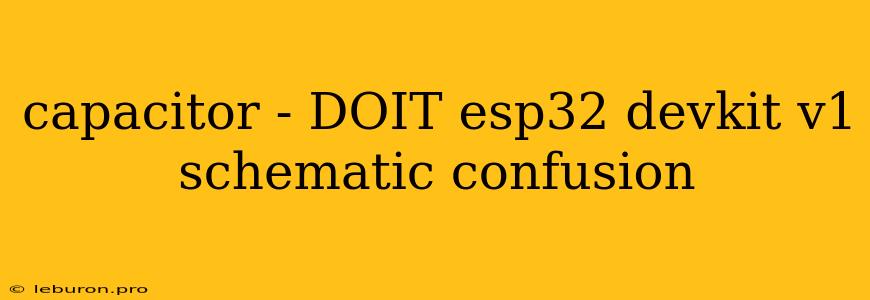The ESP32 DevKit V1 is a popular development board for hobbyists and professionals alike. It offers a wealth of features, including Wi-Fi, Bluetooth, and a powerful processor. However, many users, especially beginners, encounter confusion when trying to understand the board's schematic, particularly regarding the capacitor components. This article will provide a comprehensive explanation of the capacitor usage on the ESP32 DevKit V1, shedding light on their functions and addressing common misconceptions.
Capacitor Roles in the ESP32 DevKit V1
Capacitors are fundamental electronic components that store electrical energy in an electric field. They play crucial roles in various circuits, including the ESP32 DevKit V1. Here's a breakdown of the capacitor functions:
1. Power Supply Filtering:
-
Capacitors are employed to smooth out the DC voltage supplied to the ESP32 chip. This is achieved by filtering out high-frequency noise and ripples present in the power supply line. The filtered, stable voltage ensures the reliable operation of the ESP32.
-
C1 and C2 are the main capacitors responsible for power supply filtering. They are typically ceramic capacitors with high capacitance values (usually in the range of 100µF or more). These capacitors provide a low-impedance path for high-frequency noise, effectively smoothing out the DC voltage.
2. Decoupling:
-
Decoupling capacitors are placed close to power pins of ICs (integrated circuits) to minimize voltage fluctuations during sudden current draws. When a component, like the ESP32, demands a large amount of current, the capacitor provides a temporary source of energy, preventing voltage drops that could lead to malfunction.
-
Capacitors like C3, C4, and C5 are decoupling capacitors. They are usually small ceramic capacitors with values ranging from 0.1µF to 1µF. These capacitors are placed directly next to the power pins of the ESP32 chip, minimizing the impedance of the power supply path and ensuring stable operation.
3. Timing and Oscillator Circuits:
-
Capacitors are essential for setting the timing and frequency of oscillators in electronic circuits. The ESP32 utilizes a crystal oscillator to provide an accurate timing reference for its internal operations.
-
Capacitor C6 is connected to the crystal oscillator circuit. Its capacitance value helps determine the frequency of the oscillator, which is crucial for the ESP32's reliable timing and clock signals.
4. Input and Output Filtering:
-
Capacitors can be used to filter out high-frequency noise from input signals and smooth out output signals. This is particularly important for sensitive circuits or when dealing with signals susceptible to interference.
-
Capacitor C7 is connected to the GPIO22 pin. This capacitor helps filter out noise from signals received by GPIO22, ensuring a clean and reliable input. Similarly, capacitors can be added to output signals to minimize noise and ensure smooth signal transitions.
5. Bypass Capacitors:
-
Bypass capacitors are placed in parallel with the power supply lines to provide a low-impedance path for high-frequency noise. They are particularly effective in digital circuits where fast transitions can cause voltage drops.
-
Capacitors like C8 and C9 are bypass capacitors. They are usually small ceramic capacitors with values in the range of 0.1µF or less. These capacitors effectively divert high-frequency noise away from the power supply lines, ensuring cleaner power for the ESP32.
Understanding the Schematic:
The ESP32 DevKit V1 schematic can appear daunting at first glance, but it's crucial to break it down systematically. It's essential to understand the roles of each capacitor and their corresponding component designations. The following points can aid in deciphering the schematic:
-
Component Designations: Pay attention to the component designations like C1, C2, etc., as these correspond to specific capacitors on the schematic.
-
Capacitor Values: Note the capacitance values (e.g., 100µF, 0.1µF) for each capacitor. The values provide insights into the capacitor's function and operating characteristics.
-
Connections: Observe how the capacitors are connected to other components, especially the power supply lines, the ESP32 chip, and other ICs. This helps determine their roles in the circuit.
-
Reference Designs: Consult official ESP32 reference designs or documentation provided by the manufacturer to gain a deeper understanding of the capacitor usage and their specific functions.
Common Misconceptions about Capacitor Usage
-
Not All Capacitors are Created Equal: Different types of capacitors, such as ceramic, electrolytic, and tantalum, have distinct characteristics. Choosing the appropriate type for a given application is essential for optimal performance.
-
Capacitor Placement Matters: Placing capacitors in close proximity to the components they are meant to decouple or filter is crucial for effective operation.
-
Capacitor Values Affect Performance: The capacitance values can impact the effectiveness of filtering, decoupling, and timing functions. It's important to select the right values for the desired performance.
-
Capacitor Failure Can Cause Issues: If a capacitor fails, it can lead to malfunctioning circuits, voltage fluctuations, or even damage to other components. It's essential to use reliable and high-quality capacitors.
Conclusion:
The ESP32 DevKit V1's schematic can be a source of confusion for many users. However, understanding the roles of capacitors and their connections within the circuit is essential for successful development. This article has provided an in-depth explanation of the capacitor usage on the ESP32 DevKit V1, addressing common misconceptions and offering tips for navigating the schematic. By appreciating the importance of capacitors in electronic circuits, developers can enhance their understanding of the ESP32 DevKit V1 and build more robust and reliable projects.
